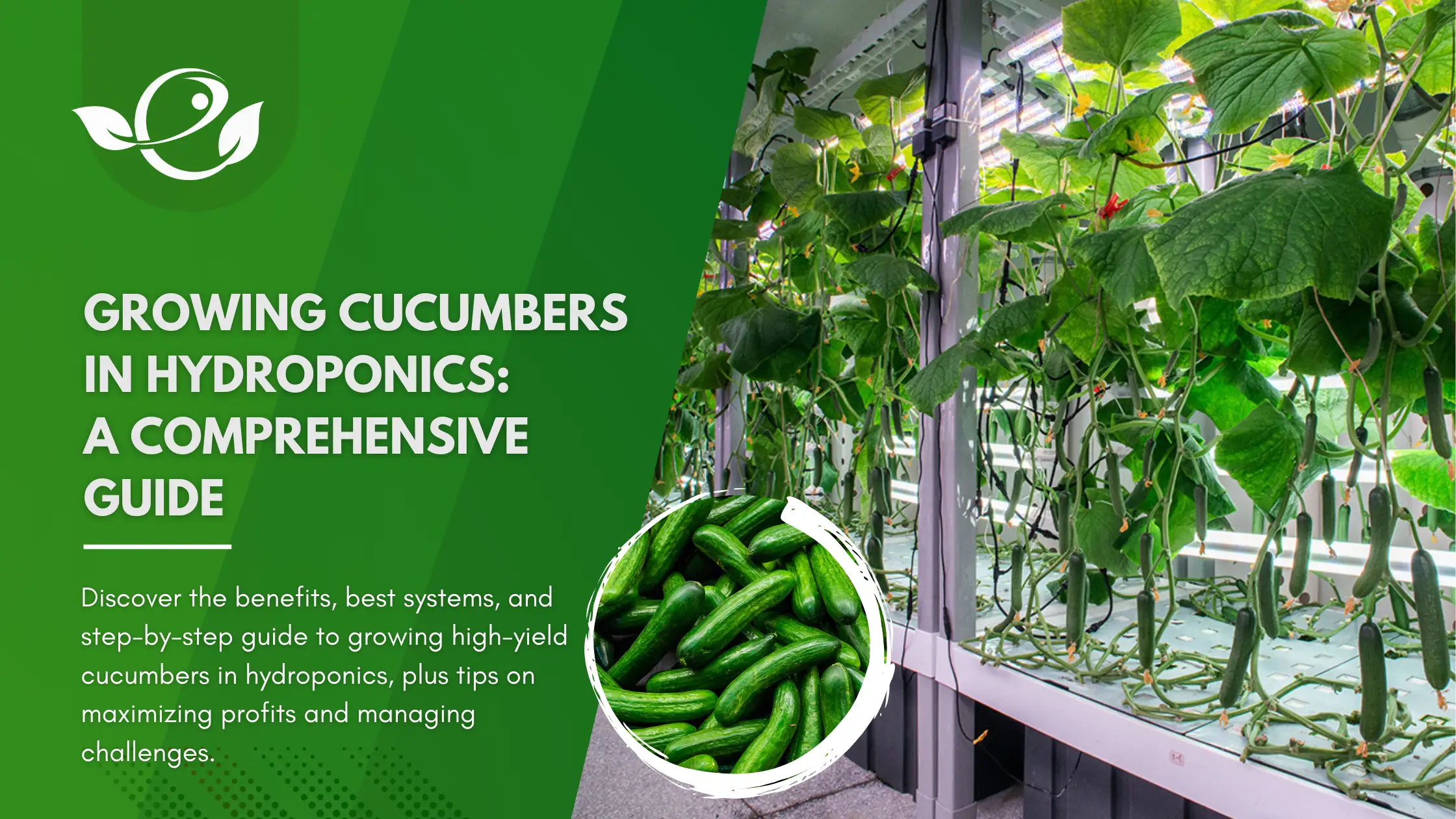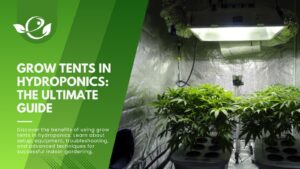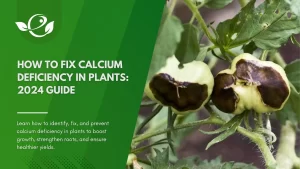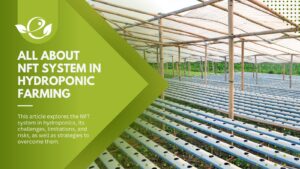Table of Contents
We all love a good, fresh, and juicy cucumber. But have you ever thought about growing them yourself, and not just in the traditional soil, but using water? This blog aims to provide an in-depth guide on growing cucumbers in a hydroponic system.
Hydroponics is an innovative and sustainable method of farming that doesn’t require soil. Instead, plants are grown in nutrient-rich water, which can lead to faster growth and higher yields. One of the most suitable vegetables for this method of farming is the cucumber. This article will guide you through the fundamentals of growing cucumbers in hydroponic systems, discussing essential factors, benefits, and step-by-step techniques for successful cultivation.
Benefits of Hydroponic Cucumbers
Hydroponic cucumber cultivation offers numerous advantages compared to traditional soil-based farming, particularly for commercial or urban growers seeking high yield, efficiency, and quality. Here are the primary benefits in detail:
A. Enhanced Resource Efficiency
- Water Conservation
- Hydroponics uses a closed-loop system, recycling water and nutrients. This system can save up to 90% of the water used in soil farming, which is particularly beneficial in areas with water scarcity.
- No runoff water means nutrients stay within the system, preventing pollution of surrounding soil or waterways.
- Reduced Land Requirement
- Hydroponics can be implemented in controlled environments, requiring less land than soil farming. This makes it viable for urban or small-space farming, where real estate is limited.
- Vertical farming methods allow for stacking, further optimizing space usage and enabling large production volumes in a smaller footprint.
B. Faster Growth and Higher Yield
- Accelerated Growth Rate
- Hydroponic systems deliver nutrients directly to the root system, enabling cucumbers to grow up to 50% faster than in soil. Faster growth rates mean multiple harvests per year, increasing profitability.
- Cucumbers have shorter harvest cycles in hydroponics, often reaching maturity in 35-45 days post-transplant, compared to 50-70 days in soil.
- Increased Productivity
- Due to optimal nutrient and water availability, hydroponic cucumber plants produce higher yields per plant.
- Consistency in growing conditions allows each plant to reach its maximum yield potential, reducing crop variability and enhancing profitability.
C. Pest and Disease Management
- Reduced Soil-Borne Diseases
- Soil is often a source of bacterial and fungal infections, such as root rot. Hydroponics eliminates this risk by removing soil entirely, protecting cucumber plants from soil-borne pathogens.
- Fewer diseases result in healthier plants, reducing the need for pesticides and improving overall produce quality.
- Less Pesticide Use
- Hydroponic environments, especially when indoors, create barriers against common pests and pathogens.
- Healthier plants with fewer pests reduce the need for chemical pesticide treatments, creating a cleaner, safer product for consumers.
D. Consistent Product Quality
- Controlled Environment for Uniform Quality
- Hydroponics allows precise control over growing conditions, including temperature, humidity, and nutrient concentration. This control results in cucumbers of uniform size, shape, and taste.
- Ideal for markets that demand consistent produce quality, such as restaurants, grocery stores, and food services, where appearance and taste standards are high.
- Enhanced Nutritional Profile
- Because hydroponic systems allow careful nutrient control, cucumbers grown this way can have a balanced and possibly richer nutritional profile than soil-grown cucumbers, depending on nutrient formulation.
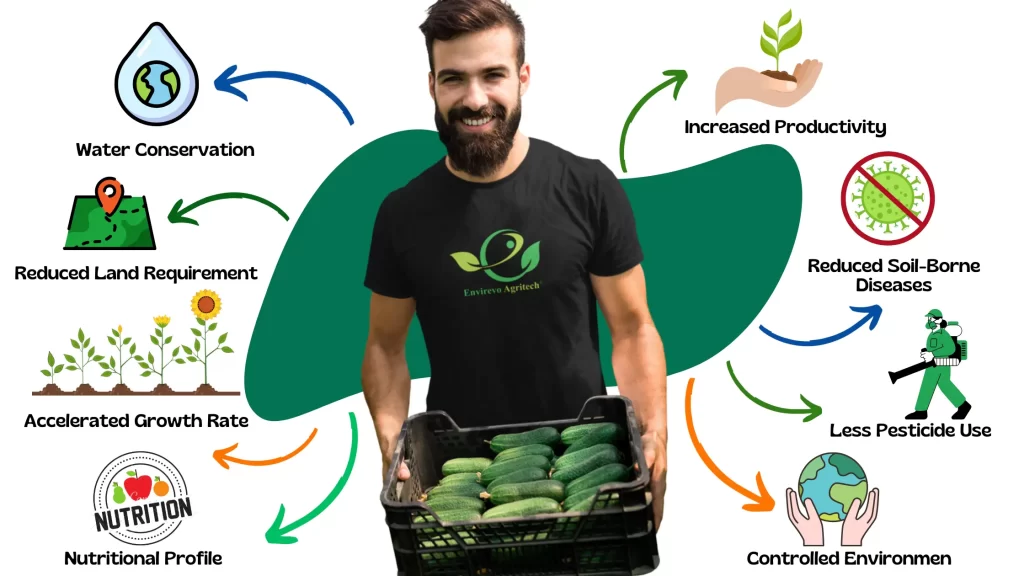
Key Factors for Hydroponic Cucumber Cultivation
Effective hydroponic cucumber cultivation hinges on several critical factors, including climate control, nutrient balance, and system maintenance. Each of these factors requires specific parameters and monitoring to ensure optimal plant health and productivity.
A. Climate Requirements
Hydroponic cucumbers thrive in a carefully controlled environment. Key climate factors to monitor include:
- Temperature
- Ideal Range: 22-26°C (72-78°F) during the day and slightly lower at night (18-20°C or 64-68°F).
- Temperature Management: Excessive heat can cause fruit bitterness, while low temperatures slow down growth. Use climate control systems to maintain consistent temperatures, especially in controlled environments like greenhouses.
- Humidity
- Optimal Humidity: 60-70% relative humidity to encourage healthy leaf growth and reduce water loss through transpiration.
- Humidity Management: High humidity can promote mold and mildew growth; ensure adequate ventilation to prevent these issues.
- Light Intensity and Duration
- Light Needs: Cucumbers need 14-16 hours of light daily for optimal growth. For indoor hydroponic systems, use full-spectrum grow lights that mimic sunlight.
- Light Intensity: Recommended light intensity is 500-700 µmol/m²/s for cucumbers. This can vary based on plant stage—seedlings need less light than mature plants.
B. Nutrient Solution
A balanced nutrient solution is the foundation of successful hydroponic cucumber cultivation. Key elements include:
- Macronutrient Needs
- Nitrogen (N): Vital for vegetative growth; cucumbers require moderate nitrogen levels to encourage healthy leaf and stem growth without excessive foliage.
- Phosphorus (P): Supports root development and fruit formation; cucumbers need consistent phosphorus throughout growth stages, with an increase at flowering.
- Potassium (K): Essential for fruiting and overall plant health; potassium aids in regulating water balance and improving disease resistance.
- Micronutrient Needs
- Essential micronutrients for cucumbers include calcium, magnesium, iron, zinc, and manganese. Each plays a unique role in plant development:
- Calcium: Strengthens cell walls, preventing blossom-end rot.
- Magnesium: Central component of chlorophyll, essential for photosynthesis.
- Iron: Critical for enzyme and chlorophyll function.
- Essential micronutrients for cucumbers include calcium, magnesium, iron, zinc, and manganese. Each plays a unique role in plant development:
- Adjusting Nutrient Ratios by Growth Stage
- During early growth (vegetative stage), maintain balanced levels of N-P-K.
- In the fruiting stage, increase potassium to support fruit formation while keeping nitrogen moderate to prevent excessive leafiness.
C. pH and EC (Electrical Conductivity) Levels
Maintaining proper pH and EC levels ensures cucumbers can absorb nutrients effectively:
- pH Level
- Target Range: 5.5-6.5 for optimal nutrient uptake. pH outside this range can lead to nutrient lockout, inhibiting plant growth and health.
- Regular Monitoring: Use a pH meter to check levels at least twice weekly. Adjust using pH up or down solutions as needed.
- EC Level
- Target Range: 1.8-2.4 mS/cm, adjusted based on plant age and nutrient uptake.
- Adjustments: Higher EC levels indicate more concentrated nutrients; reduce EC if you observe nutrient burn symptoms (brown leaf edges).
D. Water Quality and Management
Cucumbers are sensitive to water quality, so clean, low-salinity water is essential:
- Filtration and Purification
- Use filtered or RO water to remove excess minerals and impurities. Excess salts or chlorine in tap water can harm plant roots and hinder nutrient absorption.
- Temperature of the Nutrient Solution
- Aim to keep nutrient solution temperature between 18-22°C (64-72°F) to prevent root stress. Warmer water may cause root disease, while colder water slows nutrient uptake.
- Regular Solution Changes and Oxygenation
- Replace the nutrient solution every 10-14 days to prevent salt buildup and ensure fresh nutrient supply.
- Use air stones or oxygen diffusers to oxygenate the solution, especially in systems like DWC, where roots are submerged in water.
E. Monitoring and Maintenance
Consistent monitoring of the environment and nutrient conditions is crucial for hydroponic cucumbers:
- Monitoring Equipment
- Invest in pH and EC meters, thermometers, and humidity gauges for frequent monitoring.
- For larger operations, consider automated systems that adjust pH, EC, and temperature automatically.
- Regular Cleaning and System Checkups
- Clean and disinfect the hydroponic system every few weeks to prevent algae and pathogen buildup.
- Inspect plants daily for signs of disease, pests, or nutrient deficiencies, addressing issues immediately to maintain plant health.
Best Hydroponic Systems for Growing Cucumbers
Choosing the right hydroponic system is crucial for growing cucumbers effectively, as cucumbers have unique requirements such as ample root space and stable support for their climbing vines. Here are some of the most suitable systems for hydroponic cucumber cultivation, along with their respective advantages.
A. Nutrient Film Technique (NFT)
NFT is one of the most popular hydroponic systems for vine crops like cucumbers. In this setup, a shallow stream of nutrient solution flows through channels where plant roots are partially submerged.
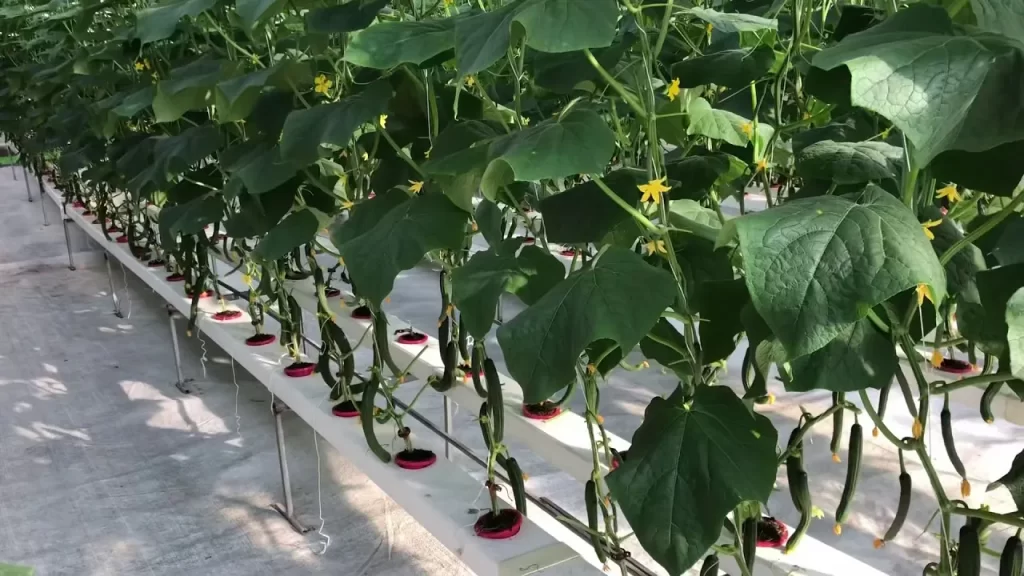
Advantages:
Efficient Use of Nutrients and Water: Nutrients are constantly recycled, minimizing waste and reducing overall resource use.
Good Oxygen Supply: As roots are only partially submerged, they receive an optimal balance of oxygen and nutrients.
Considerations:
NFT systems can be sensitive to temperature changes; overheating the nutrient film can damage cucumber roots.
Regular maintenance is essential to prevent clogging in the nutrient channels.
B. Deep Water Culture (DWC)
In DWC, plant roots are suspended in oxygenated nutrient-rich water. This system provides easy access to nutrients and supports rapid growth.
- Advantages:
- Constant Nutrient Access: Cucumber roots are immersed in a nutrient solution, allowing consistent nutrient uptake.
- Simple Design: Ideal for beginners due to its straightforward setup.
- Considerations:
- Cucumber plants can grow large, so a sturdy support structure is needed.
- Maintaining water temperature is crucial; warm water can lead to root diseases.
C. Dutch Bucket System
The Dutch Bucket system is well-suited for large, vining crops like cucumbers. Each plant has its own bucket filled with a growing medium (e.g., perlite or coco coir), and the nutrient solution is delivered directly to each bucket.

Advantages:
Individual Plant Care: Each plant is isolated, allowing better disease management and nutrient customization.
Scalable Design: The system is easily scalable for larger production.
Considerations:
Requires regular monitoring to ensure nutrient flow consistency.
Periodic cleaning is needed to avoid salt buildup in the growing medium.
D. Drip System
The drip system delivers a controlled nutrient solution to each plant using emitters, making it suitable for larger plants like cucumbers.
- Advantages:
- Customizable Watering: Each plant’s nutrient and water supply can be adjusted individually.
- Versatile Growing Mediums: Drip systems can use various substrates, such as rockwool, perlite, or coco coir.
- Considerations:
- Regular maintenance is required to prevent clogging in the emitters.
- Water runoff needs to be managed, especially if used outdoors.
E. Grow Bag System
The Grow Bag system utilizes bags filled with growing mediums like coco coir or perlite. This setup works well with a drip irrigation system to deliver nutrients.
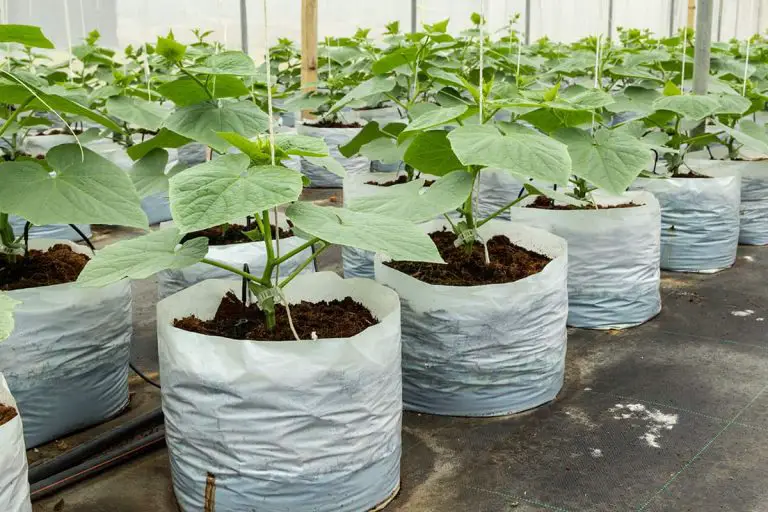
Advantages:
Portable and Space-Efficient: Grow bags are easy to set up and rearrange as needed.
Good Root Development: Allows for excellent aeration and root growth in a confined space.
Considerations:
Grow bags dry out more quickly than other systems, requiring frequent watering.
Suitable drainage is essential to prevent root rot.
Selecting Cucumber Varieties for Hydroponics
Choosing the right cucumber variety is essential for successful hydroponic farming, as some varieties adapt better to controlled environments than others. Below are the types of cucumbers best suited for hydroponics, including some specific cultivars that thrive in soilless systems.
A. Criteria for Selection
- Compact Growth and Controlled Vining
- Compact or bushy varieties with controlled vining habits are ideal for hydroponics as they require less vertical space and are easier to train on trellises.
- High Yield and Disease Resistance
- Choose high-yielding varieties that produce a consistent crop. Additionally, disease resistance to common pathogens like powdery mildew or cucumber mosaic virus is beneficial.
- Parthenocarpic Varieties (Seedless)
- Parthenocarpic cucumber varieties produce fruit without pollination, leading to seedless cucumbers that are smoother and more uniform in size and shape—perfect for hydroponic settings.
B. Recommended Varieties for Hydroponics
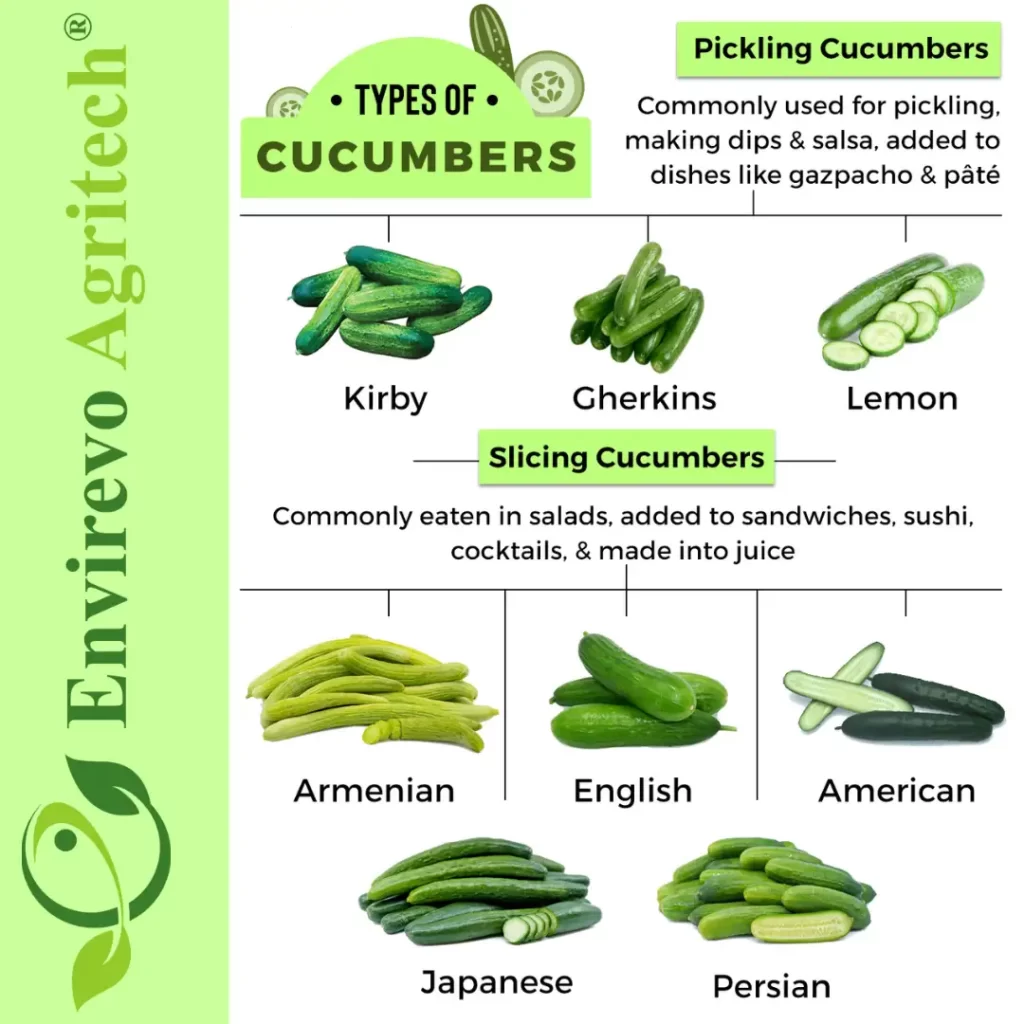

- Mini or Pickling Varieties
- Varieties: ‘H-19 Little Leaf,’ ‘Mini Munch,’ and ‘Eureka’
- Advantages: These smaller cucumbers mature faster, making them suitable for indoor hydroponics where space is limited.
- Long European or English Cucumbers
- Varieties: ‘Telegraph Improved,’ ‘Tyria F1,’ and ‘Excelsior F1’
- Advantages: Known for their thin skin and seedless nature, these cucumbers are popular in commercial hydroponics.
- Asian or Japanese Cucumbers
- Varieties: ‘Tasty Jade’ and ‘Kyoto 3’
- Advantages: These slender, tender-skinned cucumbers are highly productive and well-suited to hydroponic conditions, particularly in warmer climates.
Step-by-Step Guide to Growing Hydroponic Cucumbers
This step-by-step guide covers the essential stages of growing hydroponic cucumbers, from setting up the system to harvesting mature fruit.
Step 1: Setting Up the Hydroponic System
- Choose the Right System
- Select a hydroponic system from the options mentioned above (e.g., NFT, DWC, Dutch Bucket) based on available space and experience level.
- Assemble Equipment
- Items Needed: Hydroponic structure, growing medium, pH meter, EC meter, nutrient reservoir, and air pump (if using DWC).
- Growing Medium: Use coco coir, perlite, or rockwool depending on the chosen system.
- Set Up a Support Structure
- Cucumbers are vining plants and will require trellises or netting for support as they grow.
Step 2: Preparing the Nutrient Solution
- Choose Nutrient Formulation
- Use a hydroponic nutrient solution specifically balanced for fruiting plants. Adjust nitrogen, phosphorus, and potassium levels based on the cucumber growth stage.
- Monitor and Adjust pH and EC Levels
- pH Level: Maintain a pH of 5.5-6.5 for optimal nutrient uptake.
- EC Range: Start with an EC of 1.8-2.0 for seedlings and increase gradually as plants mature.
Step 3: Germination and Transplanting
- Germinate Seeds
- Use seedling trays with rockwool cubes or starter plugs. Keep seeds in a warm, humid environment until germination (usually 3-7 days).
- Transplanting Seedlings
- Once seedlings develop two sets of true leaves, transplant them into the hydroponic system. Ensure that roots have enough contact with the nutrient solution.
Step 4: Maintaining Optimal Growing Conditions
- Light
- Provide 14-16 hours of light per day using LED grow lights if indoors. Position lights to cover plants evenly for uniform growth.
- Temperature and Humidity
- Maintain 22-26°C (72-78°F) and 60-70% humidity. Ensure good airflow to reduce disease risk.
- Nutrient Adjustments
- As plants enter the flowering and fruiting stages, increase potassium in the nutrient solution to support fruit development.
Step 5: Pollination (If Needed)
- Pollination Techniques
- If growing non-parthenocarpic cucumbers, consider hand pollination to ensure fruit set. This can be done by transferring pollen from male to female flowers using a small brush.
- Alternatives
- Parthenocarpic varieties don’t need pollination, saving time and ensuring seedless cucumbers.
Step 6: Pruning and Training
- Pruning Tips
- Remove lower leaves to improve airflow and reduce disease risk.
- Prune side shoots to focus plant energy on main stem growth and fruit production.
- Training on Trellises
- Secure the main stem to a trellis or netting to keep plants upright and maximize light exposure.
Step 7: Harvesting
- When to Harvest
- Harvest cucumbers when they reach the desired size, usually 8-10 inches for slicers and 4-6 inches for mini cucumbers.
- Harvesting Technique
- Use a clean, sharp knife or pruning shears to avoid damaging the plant. Regular harvesting encourages continued fruiting.
Common Issues in Hydroponic Cucumber Cultivation
Hydroponic cucumber farming has distinct advantages, but it also brings specific challenges. Addressing these issues early can improve overall crop health and yield.
A. Common Pests and Diseases in Hydroponic Cucumber
- Powdery Mildew
- Symptoms: White powder-like spots on leaves, reducing photosynthesis and stunting growth.
- Prevention: Maintain low humidity levels, ensure good airflow, and prune leaves to reduce plant density.
- Control: Use organic fungicides or sulfur-based treatments. Remove infected leaves promptly.
- Root Rot (Pythium)
- Symptoms: Brown, mushy roots and wilting plants, even with adequate water.
- Prevention: Monitor water temperature (preferably 18–22°C/65–72°F) and avoid stagnant water. Clean and disinfect equipment regularly.
- Control: Treat affected plants with hydrogen peroxide solutions or specialized anti-fungal products for hydroponics.
- Aphids and Whiteflies
- Symptoms: Yellowing leaves, sticky residue, and reduced plant vigor due to sap-sucking.
- Prevention: Introduce beneficial insects like ladybugs or parasitic wasps as biological control agents.
- Control: Apply insecticidal soap sprays or neem oil, ensuring compatibility with hydroponic crops.
- Cucumber Mosaic Virus (CMV)
- Symptoms: Mottled yellow and green patches on leaves, stunted growth, and distorted fruits.
- Prevention: Choose disease-resistant varieties, practice sanitation, and control aphid populations, which transmit CMV.
- Control: Remove and destroy infected plants as there is no cure. Implement strict hygiene practices.
B. Nutrient Imbalances
- Nitrogen Deficiency
- Symptoms: Yellowing of older leaves and reduced growth rate.
- Correction: Adjust nutrient solution to increase nitrogen levels, but avoid overcompensation as this can promote excessive foliage at the expense of fruiting.
- Calcium Deficiency (Blossom End Rot)
- Symptoms: Black, sunken spots on the blossom end of cucumbers.
- Correction: Maintain stable pH levels around 5.5–6.5 and ensure calcium is included in the nutrient mix. Consider foliar calcium sprays for quick correction.
- Magnesium Deficiency
- Symptoms: Yellowing between leaf veins, starting with older leaves.
- Correction: Adjust the nutrient solution to include magnesium sulfate (Epsom salt), ensuring appropriate nutrient ratios.
- pH and EC Fluctuations
- Issues: Inconsistent pH or electrical conductivity (EC) can inhibit nutrient uptake.
- Solution: Check pH and EC levels daily. Adjust nutrient solution and water quality to maintain stable conditions.
C. Environmental Issues
- Temperature Fluctuations
- Ideal Range: Cucumbers grow best at 22–26°C (72–78°F) during the day and 18–20°C (65–68°F) at night.
- Management: Use heating or cooling systems to regulate temperatures, especially in extreme climates.
- Humidity Control
- Optimal Range: Maintain humidity between 60–70% to prevent disease and encourage healthy growth.
- Management: Dehumidifiers and proper ventilation can help manage humidity levels, while misting systems provide additional moisture when needed.
- Lighting Issues
- Solution: Ensure 14–16 hours of consistent, even lighting for cucumber plants. Adjust light intensity and placement to prevent uneven growth or “leggy” plants.
Yield and Economics of Hydroponic Cucumber Farming
Hydroponic cucumber farming offers the potential for high yields and economic viability, particularly with the right system, crop management, and market access. Here, we break down the essential economic considerations for hydroponic cucumber farming.
A. Expected Yield per Square Meter
- Yield Estimates
- High-Performance Systems: Yields can reach 5–6 kg per plant per crop cycle with intensive systems like Dutch Buckets or DWC.
- Crop Cycles: Depending on the setup, 3–4 crop cycles per year are possible with good management and environmental control.
- Yield Factors
- Variety Selection: Parthenocarpic cucumber varieties typically yield higher since they don’t require pollination.
- System Type: Systems with optimized nutrient and aeration (like NFT or Dutch Bucket) contribute to consistent, high yields.
B. Cost of Production
- Initial Setup Costs
- Hydroponic System: Cost varies depending on scale and type (e.g. Grow Bags, Dutch Bucket); expect approximately ₹10–12 lakh per 500 m² setup.
- Grow Lights: LED lights may increase setup costs but are essential for indoor cultivation.
- Other Equipment: Nutrient tanks, air pumps, pH/EC meters, and support structures add to the initial investment.
- Recurring Costs
- Nutrients and Water: Approximate cost is ₹2–3 per plant per month for nutrient solutions.
- Electricity: Includes lighting, pumps, and temperature control systems, often ranging between ₹3,000–₹5,000 per month for a medium-sized setup.
- Labor Costs: Skilled labor for daily monitoring, pruning, and maintenance, generally ₹15,000–₹20,000 per month, depending on the region.
C. Profitability and Market Potential
- Selling Price
- Hydroponically grown cucumbers can fetch premium prices, typically 20–30% higher than soil-grown counterparts due to quality and pesticide-free attributes.
- Market Channels
- Local Markets: Selling to local grocery stores, organic markets, or through farmer’s markets can provide quick returns.
- Restaurants and High-End Markets: High-end hotels and restaurants are potential buyers due to their preference for quality, aesthetically pleasing produce.
- Direct-to-Consumer Sales: Subscription models or selling through online marketplaces offers better profit margins.
- Break-Even Analysis
- The average break-even period for a medium-sized hydroponic cucumber operation is around 2–3 years, depending on market conditions, system type, and yield consistency.
Conclusion
Hydroponic cucumber farming presents a promising opportunity for growers looking to increase productivity and improve produce quality in controlled environments. By mastering nutrient management, choosing the right system, and selecting high-yield, disease-resistant varieties, farmers can achieve consistently high yields while reducing environmental impacts associated with traditional farming.
Key Takeaways:
- System Selection Matters: The choice of hydroponic system directly impacts plant growth, disease management, and yield potential.
- Disease and Pest Management: Vigilant monitoring, use of beneficial insects, and environmental controls are vital to prevent common issues like powdery mildew and root rot.
- Economic Viability: While initial setup costs are higher for hydroponics, higher yields, year-round production, and premium market prices often result in significant long-term profitability.
- Future Potential: As consumer demand grows for high-quality, pesticide-free produce, hydroponic cucumber farming offers a scalable, sustainable model for modern agriculture.
In summary, hydroponic cucumber farming offers an innovative approach to produce high-quality cucumbers with optimal use of resources. Whether targeting local markets or expanding to large-scale operations, hydroponic cucumbers can provide a viable and profitable venture with proper planning and management.
FAQ: Hydroponic Cucumber Farming
Can cucumbers be grown hydroponically indoors, and what lighting is needed?
Yes, cucumbers can thrive indoors with adequate lighting. For indoor hydroponic cucumber farming, full-spectrum LED lights are recommended, providing 14–16 hours of light per day. LEDs are efficient, don’t produce excessive heat, and allow precise control over light intensity.
Do hydroponic cucumbers taste different from soil-grown cucumbers?
Hydroponic cucumbers often have a more consistent flavor since nutrient levels and water are tightly controlled. Many find them fresher and crisper, and they’re usually pesticide-free, making them appealing for health-conscious consumers.
How much space is needed to grow cucumbers hydroponically?
Space requirements depend on the system and plant variety, but a small home setup may need just 1–2 square feet per plant. Commercial setups use vertical stacking or trellising to maximize space and yield per square meter.
What are the water requirements for hydroponic cucumber plants?
Hydroponic cucumbers require less water than soil-grown plants due to efficient recirculation systems. Depending on plant size, a hydroponic cucumber may use about 1–2 liters of water per week, which can vary with environmental conditions
How do I pollinate hydroponic cucumbers if they’re grown indoors?
Many hydroponic cucumber varieties are parthenocarpic, meaning they don’t require pollination to produce fruit. However, if using varieties that need pollination, manual pollination with a brush or introducing small pollinator insects like bees (where feasible) can help.
How long does it take to grow cucumbers hydroponically from seed to harvest?
Typically, hydroponic cucumbers take 6–8 weeks from seedling stage to harvest, depending on variety and growing conditions. Faster growth and higher yields are achieved with optimal lighting, nutrients, and temperature control.
Can I grow cucumbers hydroponically without using pesticides?
Yes, hydroponic systems often allow growers to avoid pesticides by controlling the environment and reducing soil-borne pests and diseases. Preventive measures like biological pest control and regular monitoring help maintain healthy, pesticide-free plants.
What is the lifespan of a hydroponic cucumber plant?
In hydroponic systems, cucumber plants are typically grown for 3–4 months, depending on yield and fruiting cycles. After productivity decreases, plants are replaced to ensure optimal yield.
Are there specific nutrient solutions recommended for cucumbers?
Yes, hydroponic cucumber plants benefit from nutrient solutions rich in nitrogen, potassium, and calcium. Solutions should be balanced specifically for fruiting plants, as cucumbers require more nutrients during flowering and fruiting stages.
How can I prevent algae growth in hydroponic cucumber systems?
Algae growth can be minimized by covering nutrient reservoirs to block light, maintaining proper nutrient balance, and cleaning the system regularly. Adding a small amount of hydrogen peroxide to the water can also help control algae growth safely.
